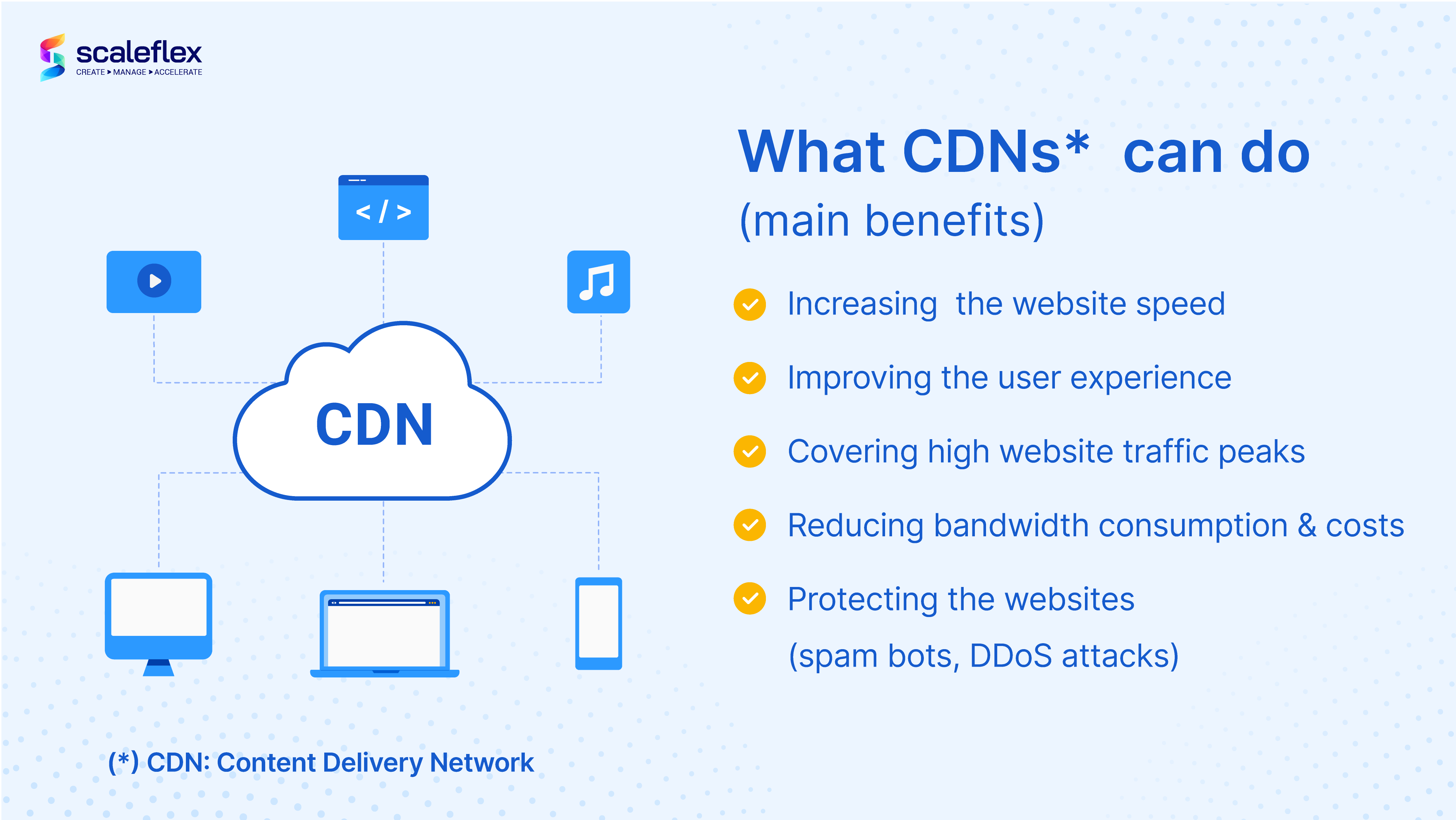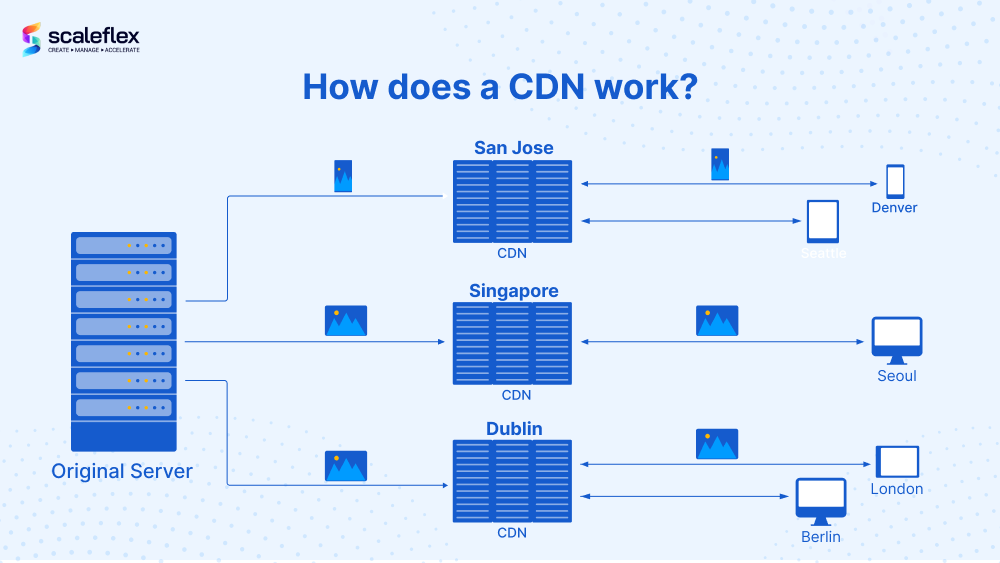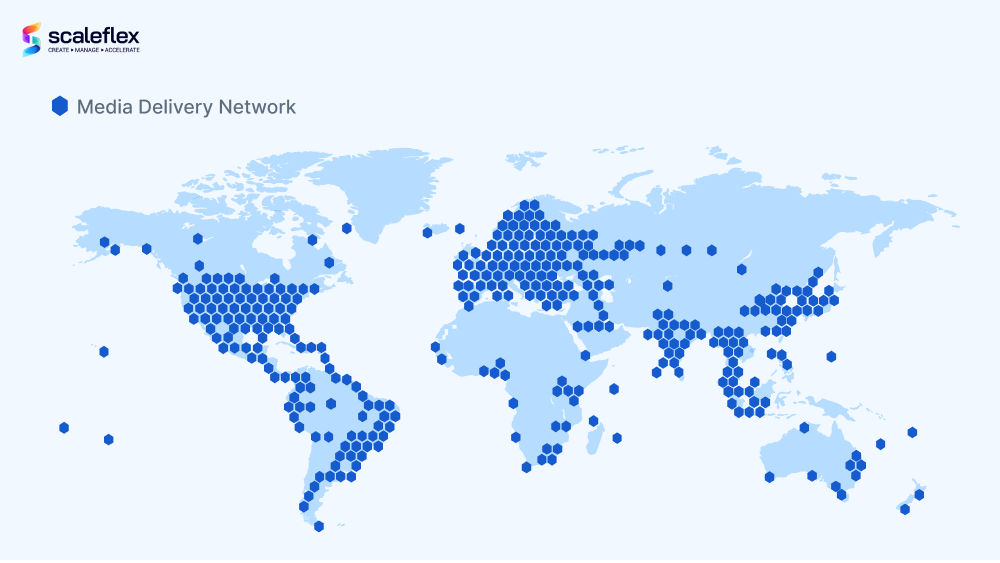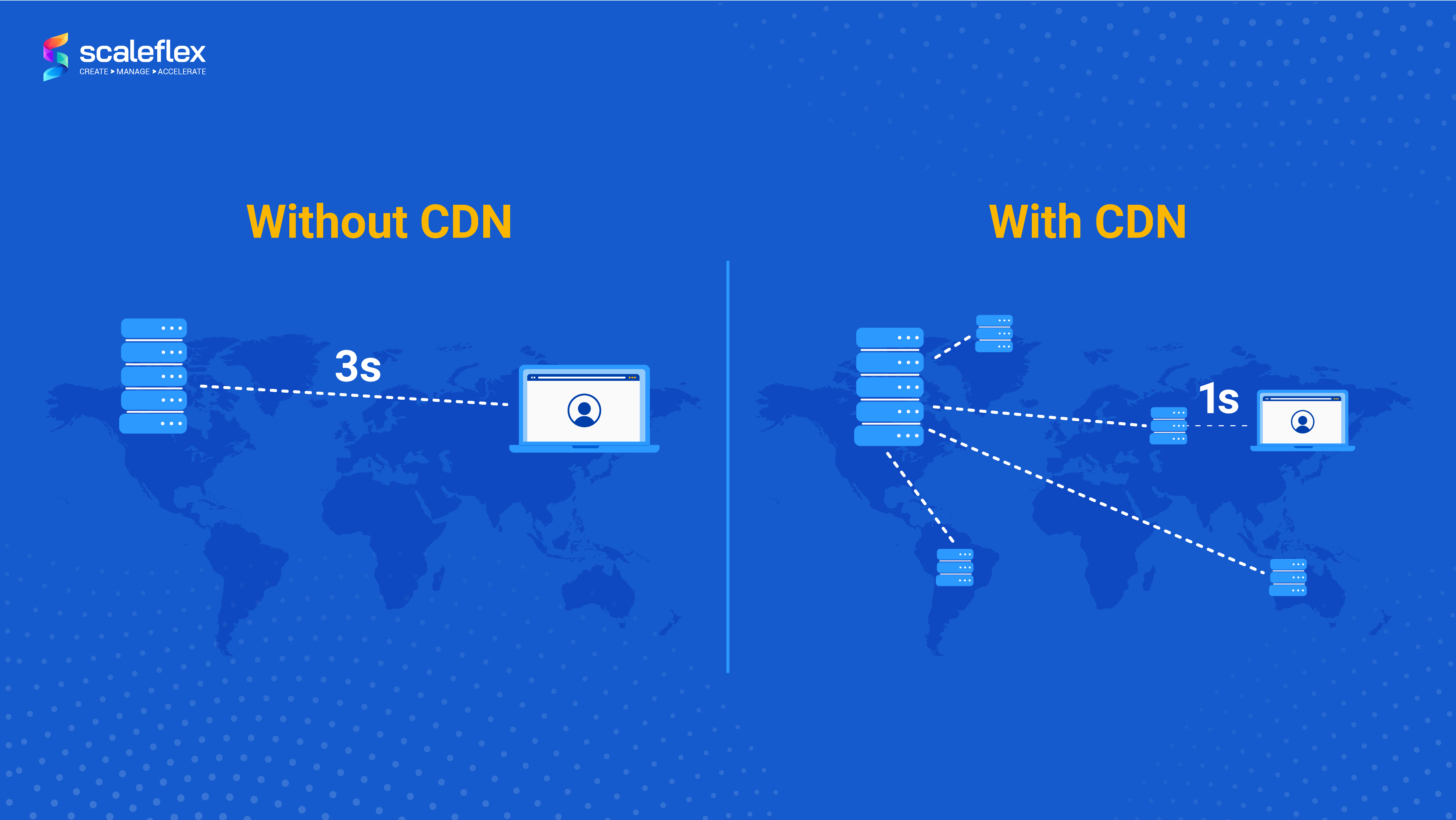Content Delivery Networks (CDNs): What Is a CDN? How Does It Work And What Are Its Benefits
What is a CDN? A content delivery network, also known as content distribution network, can be described as a crucial layer of the modern internet ecosystem. If we refer to the official CDN definition, it is a geographically distributed network of proxy servers and their data centers.
These servers impel web content distribution, and are of great help to website owners. The purpose is content delivery to online users in an efficient manner, with the slightest delay possible. In layman’s terms, the internet as we know it today could struggle to exist without the backbone that CDNs provide for the various types of digital content.
You can think of CDN as an umbrella term, covering a number of content distribution services. These services encompass software downloads, web and mobile content acceleration, video streaming, transparent caching, cloud intelligence and analytics, among others. Modern CDN providers also have adopted technologies from other industries, such as cybersecurity, with included DDoS (Distributed Denial-of-Service) protection and web application firewalls (WAF).
These networks cache web content, including pages, images, and video, in proxy servers that are close to users’ physical locations. Thanks to the caching process, users, such as yourself, can watch videos, read news articles, or purchase something online, without delay. In other words, CDNs stem from the need for stable website performance and efficient page load time.
In this article, we are going to explore the vast topic of CDN benefits. To understand in depth what is content delivery network, how it works and why we need it, we invite you to read carefully the following sections.
History of Content Delivery Networks
Let’s go back to the beginning. The very first CDN was launched in the late 90’s. At the end of 1999, the first such company had an annual revenue of nearly $4 million, managing 3,000 CDN servers globally. According to Grand View Research, in 2020, the global content delivery network market size was valued at USD 10.73 billion, and in the upcoming years to 2028, it should expand at a compound annual growth rate (CAGR) of 22.1%. Considering this significant growth, it is only natural to wonder… How did it all start?
The technology has undergone several stages of development since its inception in the 90’s, before reaching its prosperous current status. Not surprisingly, this development has been affected by various market factors, such as new content trends and connectivity improvement, i.e. optical fiber.
This evolution can be divided into three generations, each bringing its own performance capabilities, technological advancements, and new concepts in network architecture. During these development stages, the prices of CDN services have been dropping slowly, thus addressing the need of becoming a mass-market technology.
- Like we already mentioned, first generation CDNs date back to the 90’s, when content was served over static HTML and downloadable files. Most customers came from corporate sectors, and the price of the service was quite high. The focus back then was mainly on performance.
- The second generation was about both static and dynamic content, with rich media coming into the picture. The customer span started including various business sectors, with prices becoming more affordable (but still expensive).
- Third generation CDNs still rely on static and dynamic content and rich media. However, in terms of performance, availability and security have also become crucial factors.
Nowadays, since pricing has significantly dropped, every website owner can become a customer of such a vendor.
Return to the Table of ContentsBenefits of using a CDN
How can you benefit from implementing a CDN in your website?
You will benefit greatly in terms of website speed and website health in general. As we already explained, using this service will enable an agile transfer of resources, including HTML pages, images, videos, JavaScript files. It’s like using a fast speed lane, where the CDN provider is the high-tech vehicle shortening the distance between your website’s visitors and your server. This is possible, because the vendor provides a cached version of your site’s content in multiple locations, known as points of presence (PoPs). Each point of presence contains multiple servers, in charge of caching your site’s content and distributing it to your visitors within a specific vicinity (areas like Africa or China).
N.B. We should highlight that using a CDN can’t compensate for the use of a web hosting provider. The service is meant to cache your content, thus improving your site’s performance, but it can’t host it. However, if you want a quicker site, then you should definitely incorporate a CDN. In terms of site optimization, CDN benefits are great - content delivery networks are known to positively affect bounce rates, increasing the time visitors spend on your site. So, by implementing one, you will increase the traffic to your site and improve overall user experience and brand loyalty greatly.

Who are the users of CDNs?
Even though in the past content delivery networks were mostly deployed by corporate networks and large businesses, today anyone with an online business can use a CDN. Nonetheless, the service is specifically effective for larger websites with multiple components and significant traffic, as well as sites and apps with lots of dynamic content.
Various private and public sectors use and benefit from content delivery networks, including e-commerce platforms, mobile applications, media companies, technology and software-as-a-service platforms, financial institutions, government websites, start-ups and SMBs (small and midsize businesses).
How does a CDN work?
CDNs are all about caching content and improving user experience. These tasks may sound rather straightforward, but the processes behind them are complex and full of technical wizardry.
The CDN server
In order to exist, any such vendor needs content caching servers. These CDN servers are grouped into point of presence (PoPs) which are then distributed in various geographic locations. The purpose of the network is to redirect the user to the closest possible PoP. In most cases, this is done by utilizing the so-called GeoIP, a technology that allows IP address mapping to specific geographic regions, like countries, cities and largely populated areas. Upon processing a request, the network uses the GeoIP technology as a reference to direct the user to the closest available server.

The content caching process
Any website user can cache their site’s content on a CDN to deliver it to their end-users in a quick, efficient manner. Thanks to this service, the entire process is much faster than if you had to deliver it straight from the source. In other words, the user’s request to your content will go straight to the nearest possible PoP and back, rather than traveling to the origin servers and back.
Some professionals describe the content distribution technology as a large key-value database. According to MongoDB, key value databases, or key value stores, are database types, in which data is stored in a “key-value” format. The data is retrieved by a unique key (or several unique keys) to fetch the associated value with each key.
Simply put, when a request arrives, the cache is set to determine the nature of the request, locate the data, and send it back to the site visitor. There are various means to determine the type of content that should be served to the user, including domain name and query parameters, among others. To perform this task, caches leverage the so-called multi-level lookup tables, based on optimized algorithms that discover the accurate content without delay.
It is also noteworthy that networks can also purge content. Thanks to purging, the most relevant pieces of content are served.
Data security and CDNs
Without data security, none of everything described above will make any sense, especially when we consider the volume of data that goes through these networks. Recent Statista forecasts reveal that traffic to CDNs on a global scale is expected to reach 252 exabytes per month in 2022. In comparison, this traffic was measured at 54 exabytes in 2017.
According to cybersecurity specialists, “this staggering amount of traffic makes CDNs the prime target of many cyber criminals keen to intercept, alter, and steal important information.” This highlights the importance of excellent security mechanisms that each website owner should prioritize, in the context of CDN and beyond.
CDN security takes care of your site visitors by protecting them against malicious intruders. Depending on your specific implementation, security mechanisms may vary. However, the prevention of DDoS attacks and WAF (website application firewall) are considered cornerstones in CDN security.
What is a Multi-CDN?
Multi-CDN solutions merge multiple CDNs from various vendors into a unified network to improve coverage and accomplish better results in website performance.
Why is this important? Providers rely on different PoPs, network infrastructures, and features. This is why different providers deliver different results, and may vary greatly in terms of performance, security, and cost benefits. Multi-CDN allows its customers to leverage the most appropriate service according to their specific needs by directing the traffic and workload to the best possible CDN.
Furthermore, such a CDN strategy has its benefits to businesses from various backgrounds, including:
- Performance improvement on a global scale
- Continuous website uptime
- Accelerated site load times
- Flexibility and better security
- Lower costs
Just keep in mind that there is a huge difference between choosing a single Multi-CDN and choosing from multiple CDN providers. Some vendors can work with several providers, and others rely on the Multi-CDN approach. Choose wisely according to your site’s needs.

Media acceleration with CDNs
Simply said, CDN media acceleration is at the core of content distribution networks, as it reassures the smooth and high-quality delivery of your media content. Media acceleration can be divided into two major groups:
- Image CDN
- Video CDN
Image CDN is described as a content delivery network that is specifically equipped with a set of software enhancements towards optimizing images, videos and other files in real-time. Its sole purpose is enhancing rich media delivery.
Video CDN is focused entirely on improving video stream delivery. If your site depends on excellent video performance, then the use of a Video CDN will greatly improve streaming video for your viewers by minimizing latency and buffering time. It will also make sure that the stream’s source, or origin server, is not affected by the received requests.
Also, take into consideration that Image CDN delivers images and videos, which are known as "static content," whereas Video CDN can also deliver video streaming. Let’s see what the difference between static and dynamic content is.
Static content doesn’t change. The term broadly applies to HTML files and images. Generally, any file stored in a server that reaches end users in the same form is considered static content. You can think of it as a book that can’t be altered, once it hits the bookstore shelves.
Following this logic, dynamic content refers to content that changes each time it is delivered to the end user. These changes occur based on various factors, including location, time, and device type. In other words, a dynamic page is like a shapeshifter that takes a different form when each individual user interacts with it.

CDN Case Studies
Let’s have a look at a company that recently decided to implement a specific, highly-reliable CDN solution.
Zentrada is a German-based newspaper publishing house that was founded in 1949. Zentrada has been trading online via its eCommerce platform since 2002. Currently, it is the leading European wholesale company.
Each month, more than 100,000 commercial members utilize the platform to meet European suppliers and do business on the company’s TradeSafe service. This task is quite demanding, as it requires serving more than 5.6 million images on a monthly basis.
This growing demand shaped the imminent need for a strong image processing solution appeared. This is how Zentrada’s development team decided to implement a specific Image CDN service. The highlight of this case study is the success achieved in less than one week, simply by choosing the right solution for the company’s specific needs.
For more information on this success story, you can read the full case-study.
Conclusion
Considering all the relevant information about CDN benefits that we provided in this article, it’s safe to say that choosing such a solution will secure you excellent user experience. By selecting the perfect content delivery network, you will prevent site crashes, improve your site’s optimization and manage to deliver high-quality content.
A content delivery network is a “must-have” for website owners who are focused on the best current technologies, while aiming at next-level optimization in all its vigorous aspects.
This is a good place to mention Scaleflex’s Native Global Solutions, which accelerate media assets by using multiple CDNs – an approach proven to be rather successful. To accelerate the upload and delivery of assets, the technology is built upon a multilingual and globally distributed architecture, offering the following services:
- Storage Geo-zone, which aims at reducing the so-called Time To First Byte (TTFB) to less than 100 ms for any user around the world and less than 20ms for server-to-server API calls;
- Regional Variants for locally customized metadata that address your Product Information Management requirements, such as currency and language;
- Multilingual support in 4 languages (English, German, French, and Spanish);
- Global Networks coverage, which includes more than 130 countries in 5 continents, equaling to 2,000+ PoPs.
We invite you to learn more about Scaleflex’s Native Global Solutions.
Return to the Table of ContentsFAQ
What is a CDN used for?
Content delivery networks help distribute content from your site or mobile app to online users in a quick and an efficient manner, according to their geo location. This is possible thanks to the so-called Points of Presents (PoPs), which generally can be described as a network of servers.
The CDN vendor provides a cached version of your site’s content in multiple PoPs. Each PoP consists of numerous servers, in charge of caching your site’s content and distributing it to your visitors within a specific vicinity.
Why is using a CDN important?
The implementation of a content delivery network will improve your site’s performance in terms of speed. Let’s not forget that site speed is a crucial SEO factor, among other things. You will need one, especially if your site is larger and has lots of dynamic content elements. Because CDNs are meant to help distribute bandwidth across many servers, they will also help you achieve a faster, more consistent user experience.
Is CDN a Web server?
The short answer is no. A CDN is not a web host and it doesn’t host your content, meaning that it cannot replace your hosting provider. However, it ensures that your content is cached at the network edge, thus improving your site’s performing. Since traditional hosting providers may fail to address your site’s need for accelerated performance, you can opt for using a CDN.
What are the disadvantages of CDNs?
Like any service, content delivery networks do have some downsides.
Even though CDNs today are more affordable than ever before, they are still an expensive service.
If there is a discrepancy between the location of your servers and the location of your visitors, CDNs may not be as helpful as you’d hoped. This can be avoided, if you choose carefully and know your audience in-depth.
Another downside can be the support you receive, or fail to receive. Most providers are operated over third-party infrastructures, meaning that addressing your technical issues can be a complicated, lengthy process.
How do I create a CDN?
Your business may need its own CDN, i.e. when you want to get permanent cache or need guaranteed bandwidth and resources.
To create your own CDN, you will need a domain name or a subdomain, at least two servers (dedicated or virtual) in different locations, and a geoDNS tool to redirect user requests to the nearest server.
It is noteworthy that you can build a DNS server with geoDNS functionality from scratch, but it will be more efficient to use ready-made solutions.
What is the difference between CDN and cloud computing?
For starters, CDN is a “network of servers” type of technology which has been around longer than cloud computing in its current form. Cloud computing is about delivery of different services through the internet, involving tools and applications, such as data storage, servers, databases, and software. Cloud computing helps divide a large computing resource, such as processing power, into smaller pieces which you use remotely.
Cloud computing refers to a big group of servers, “situated” in one data center building, usually at one location. Whereas CDN is also a group of servers, but distributed around various locations, thus ensuring your visitors with a better and faster access to your site.





